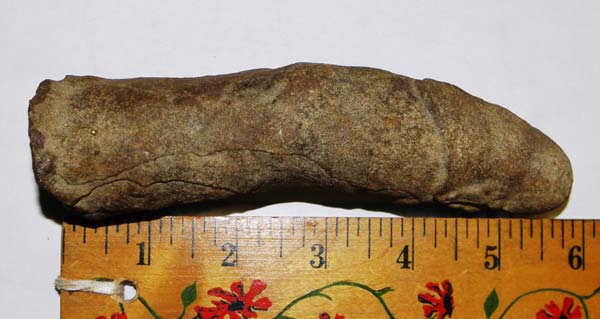Phallic-Shaped Rock Discovered in Maryland

When Martin Kenny came across what looked like a phallic carving at a site where workers had been excavating to build a new barn, he didn't know what to make of the thing.
"I was standing there and just happened to look down and said, 'Holy crap, what's that?' Kenny told LiveScience. "I put it in my trunk and said, 'What am I going to do about this?’"
Kenny, who works as a horse farrier (a specialist in hoof care), said he's contacted several academic institutions to see if they were interested in analyzing the object, but hasn't received a response. [Photos of the phallic carving]
"I've written to the Smithsonian and never got anything back from them," he said. "I wrote and said I found this stone penis, and I'm sure someone would appreciate being able to look into this thing."
Kenny first found the rock about 20 years ago near Elkton, Md., but has kept it in a drawer since, not knowing what to do with it. He recently sent photos to Swedish archaeologist Martin Rundkvist, who posted them on his blog Thursday (Dec. 9).
"To my eye, it's pretty clearly modified by human hands, though it may originally have originated as a fossil cavity of some ancient mollusk," Rundkvist wrote.
The suggestive-looking rock appears to be made of sandstone, and measures 6 inches (15 cm) long by 1.5 inches (4 cm) thick. At its base is a hole about the diameter of a pencil, Kenny said.
Get the world’s most fascinating discoveries delivered straight to your inbox.
Rundkvist said the object could potentially be of academic interest.
"I'd like to know if this is something Maryland pre-historians have found before," he wrote in an e-mail. "And I'd also like to know what sort of finds may remain to be found on the site."
It's not the first such phallic find. A Stone Age carving that scientists said looked like an "ancient dildo" was unearthed in July in Sweden. Though that item may have had a more innocent purpose as a flint-carving tool, researchers speculated. [See "Sex Myths and Taboos"]
Other than a few discoveries, though, such possibly sexual objects from the ancient world are not common, Rundkvist said.
"I don't know about Maryland, but they're very rare in Scandinavia where I work," he said.



